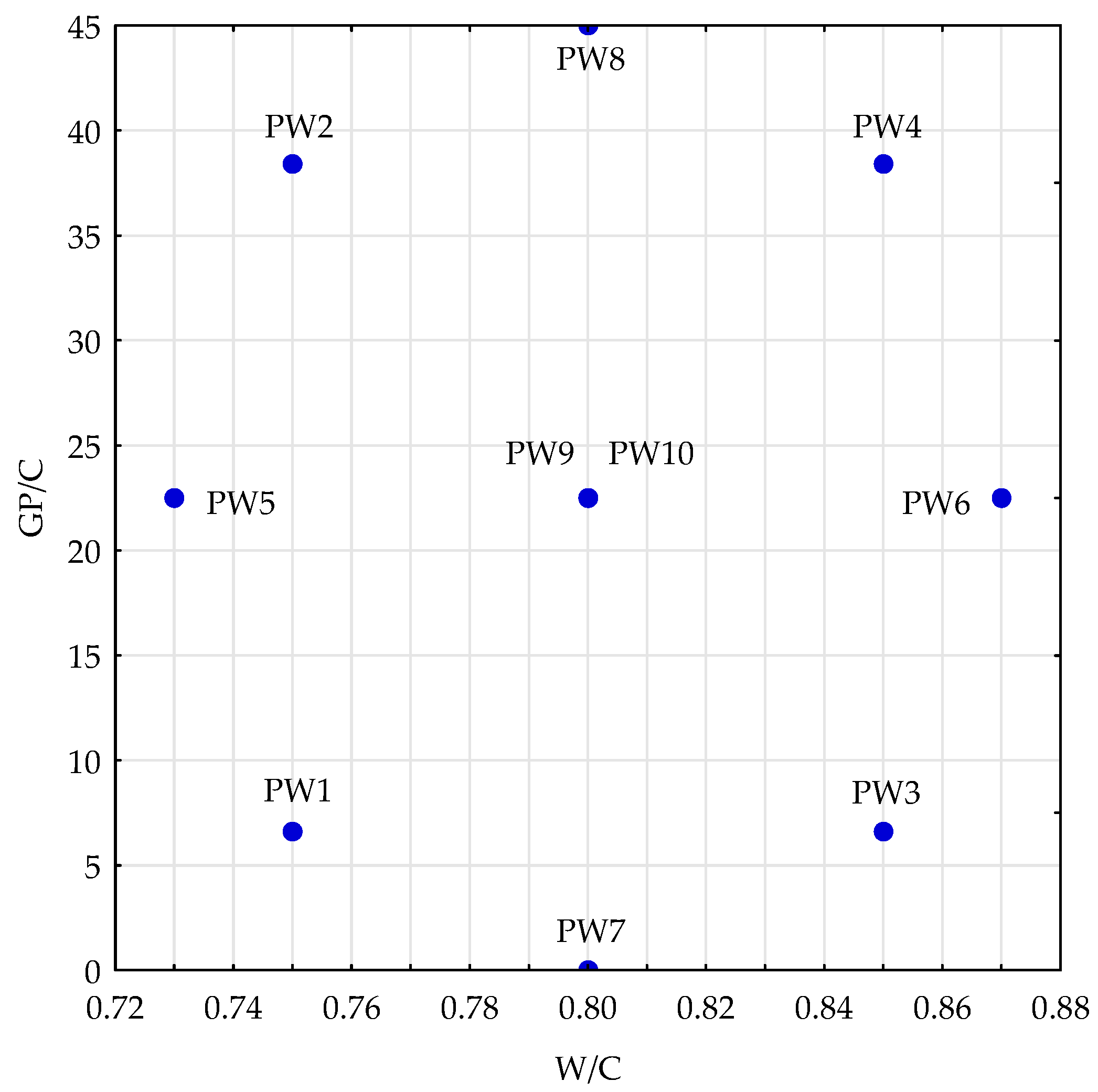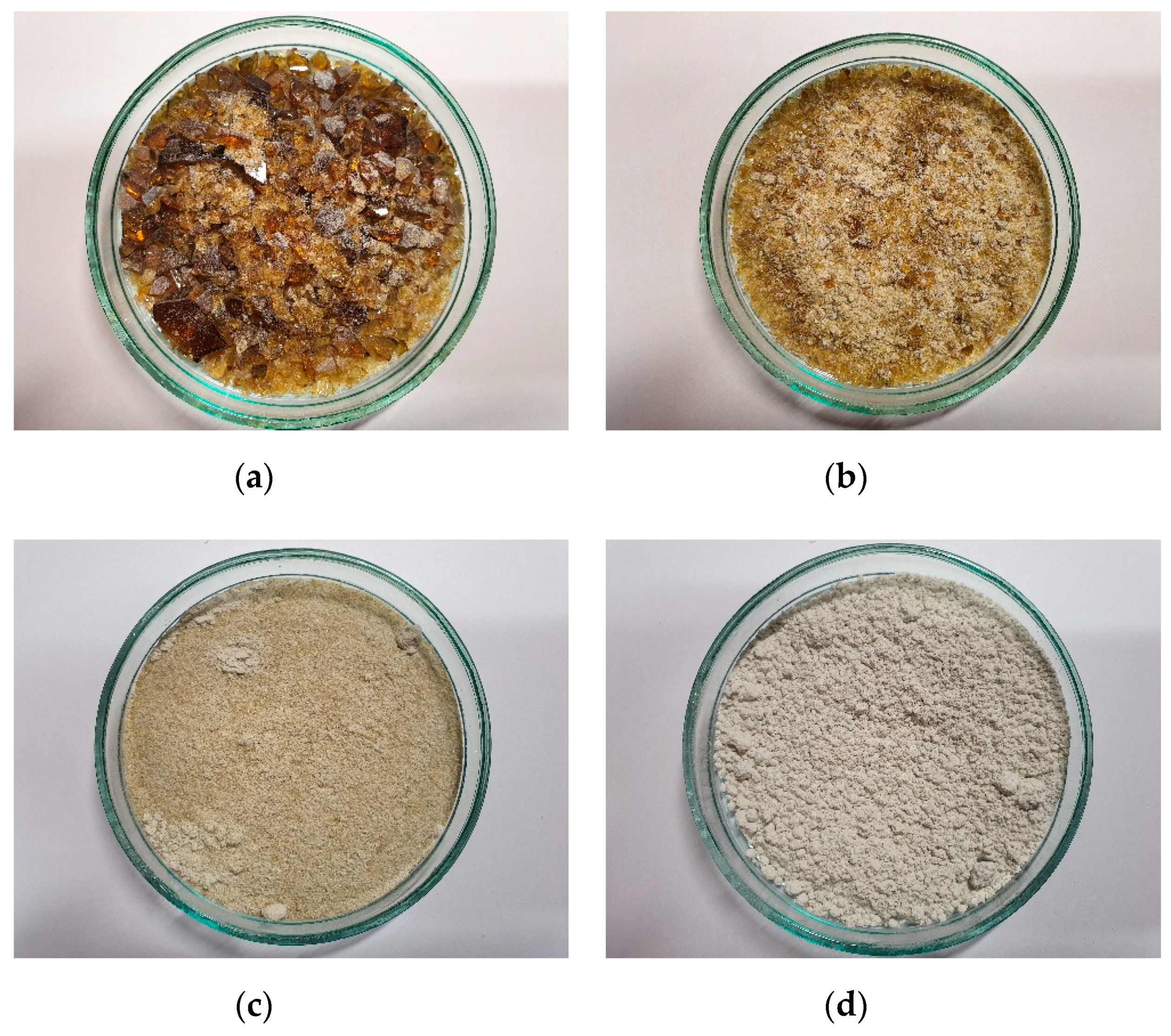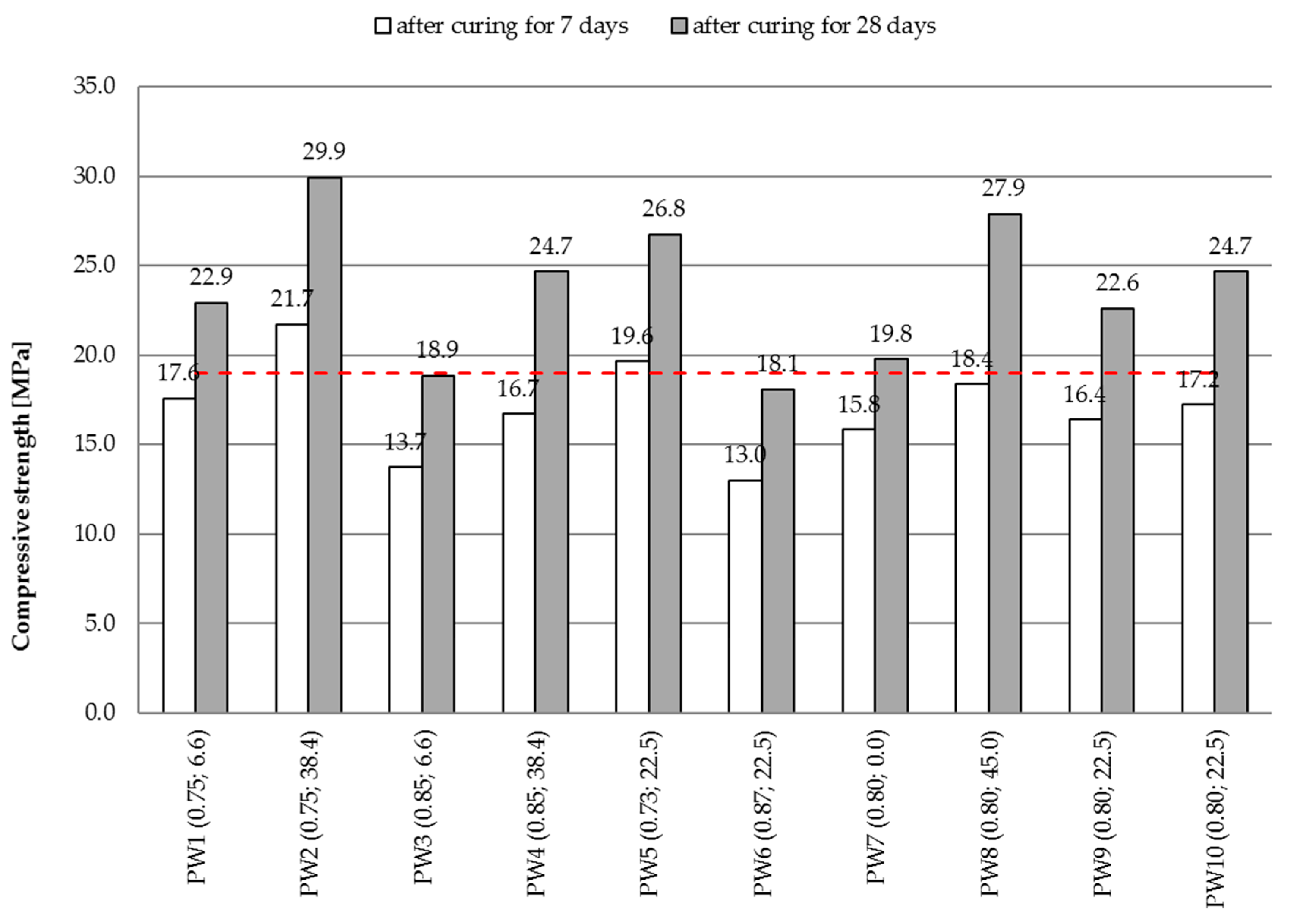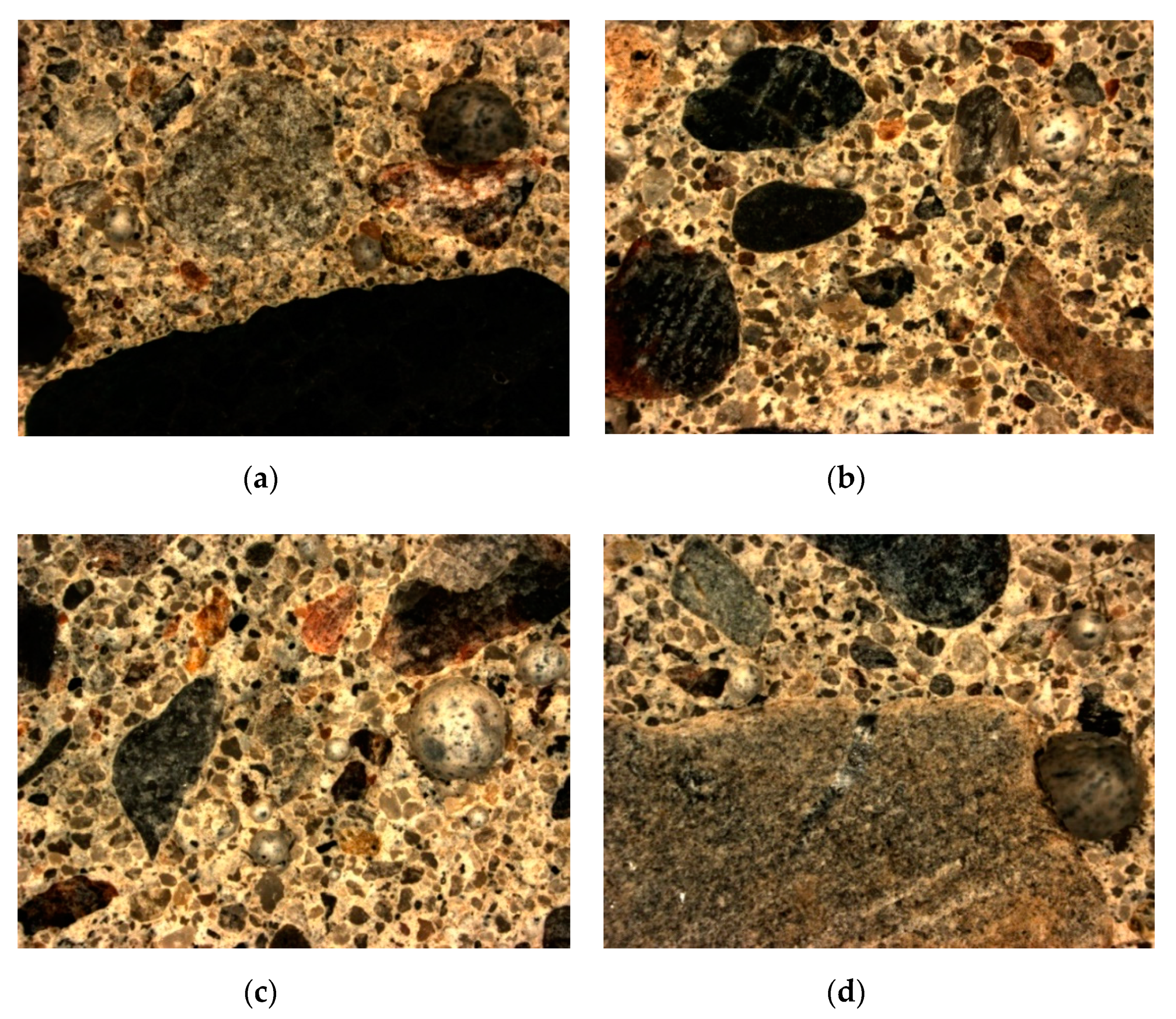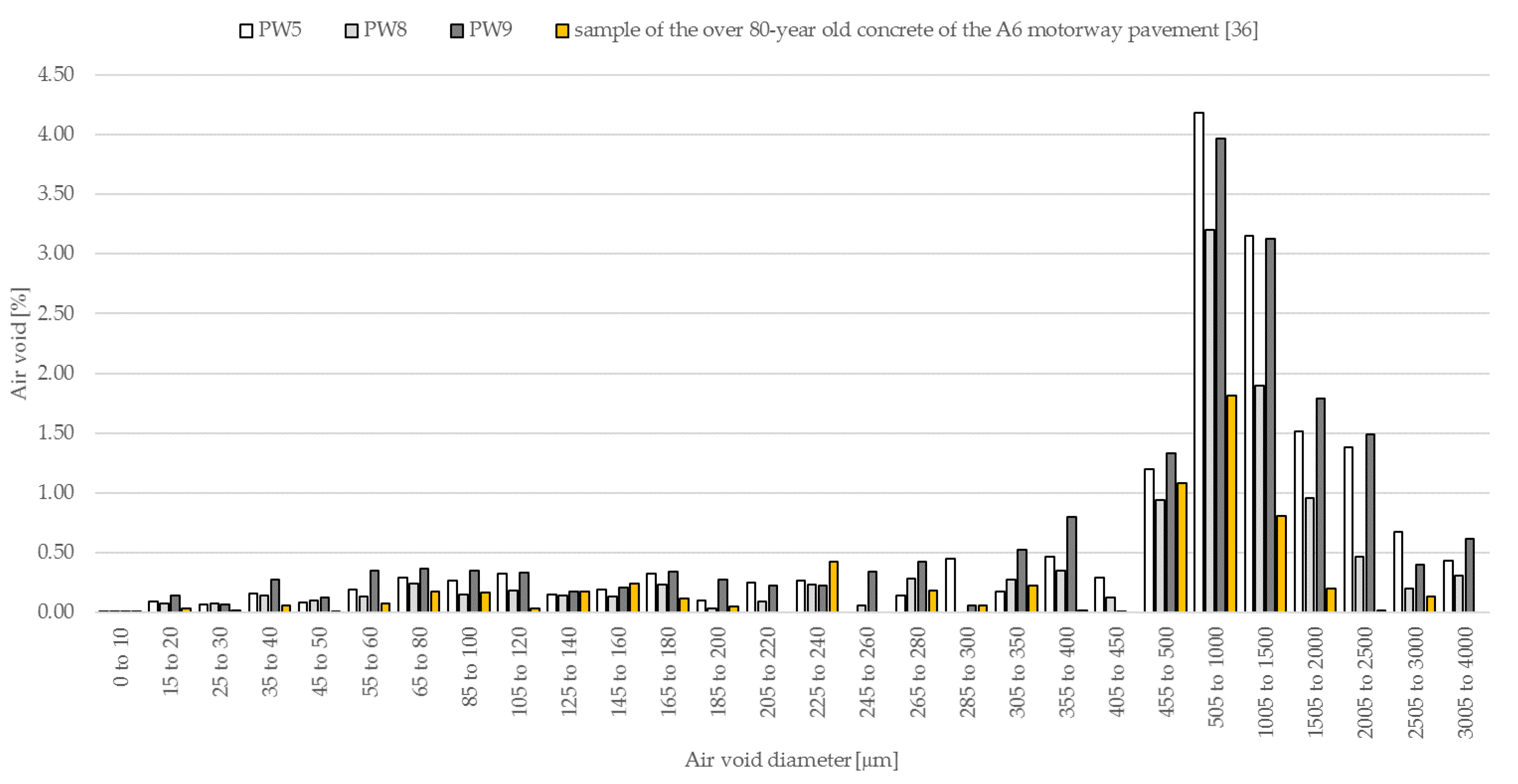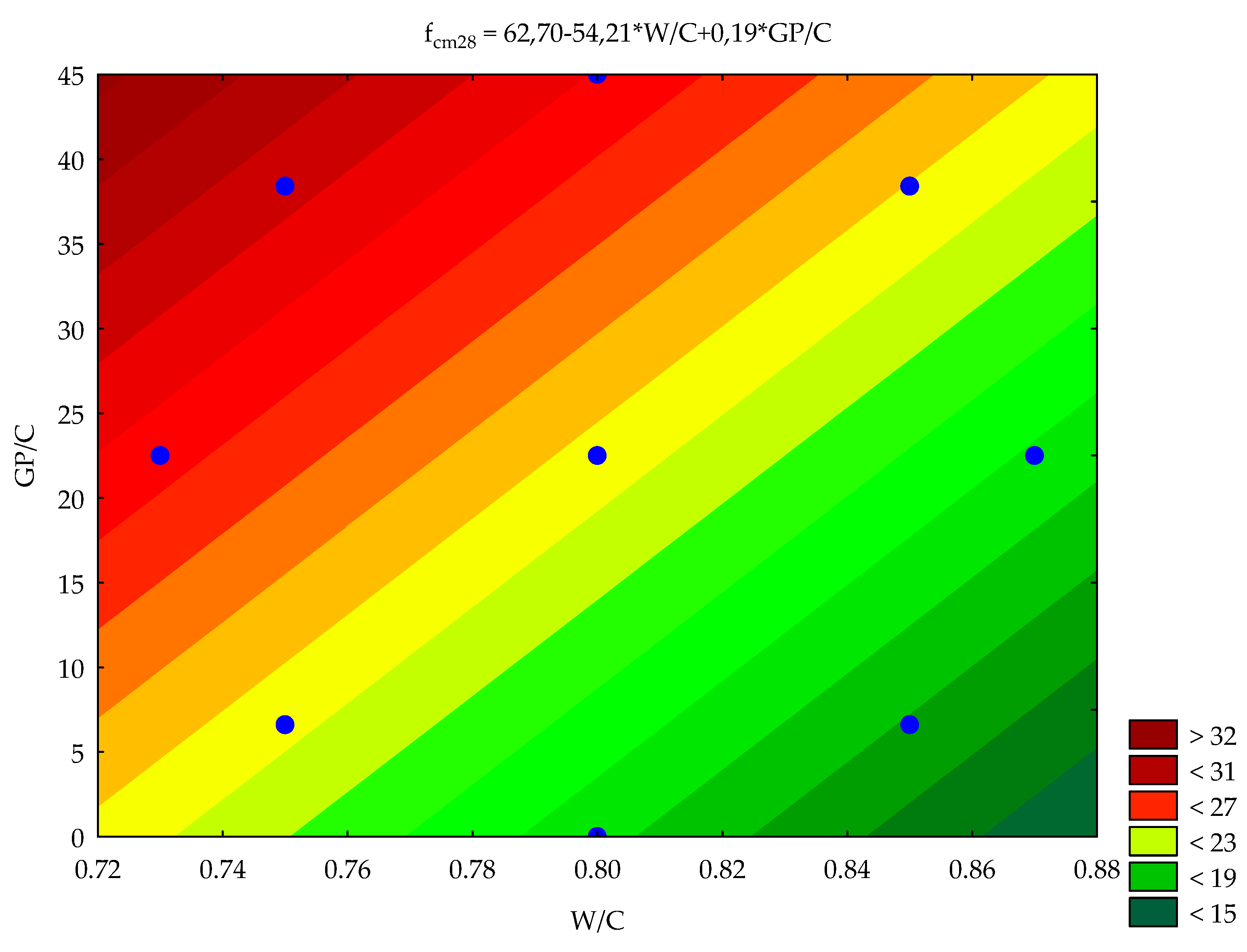1. Introduction
The aspects related to the reuse of waste materials, such as waste glass, in the field of construction have become an increasingly widely explored subject of scholarly articles. Although the amount of waste glass collected and recycled in the EU increases year by year, as demonstrated by the most recent data [
1], there are very wide variations between the member states themselves. With an over 95% glass recycling rate in Sweden, Slovenia, and Belgium; in other countries, such as Greece and Hungary, there is great room for improvement in this respect. In Poland, the average glass recycling rate in 2017 was 62.5%, i.e., it was 13.7% lower than the value of the whole of the European Union. This means that waste glass and used glass containers are, in a majority, reused in the production of brand-new products, i.e., utilised in the most efficient way. On the other hand, ca. 37.5% of this waste is not recycled at all, i.e., it is sent directly to landfill.
Currently, waste glass is used as a raw material for the production of glass fibres used in production of thermal and sound insulation panels, mats, and lagging. For example, a very fine-grained waste glass powder is used to produce expanded glass beads added to wall coatings and mortars. Another waste glass material, namely waste flat glass, is used for the production of glass microspheres [
2].
Numerous studies have been conducted on the possibility of using finely ground waste glass as a partial replacement for cement in concrete. A smaller glass particle size led to a higher compressive strength in concrete and compared to fly ash concrete, concrete containing ground glass exhibited a higher strength at both early and late ages [
3]. The compressive strength test results indicated that recycled glass mortar and concrete gave better strength compared to control samples. A 20% replacement of cement with waste glass was found to be convincing considering the cost and the environment [
4]. Test results [
5] indicate that use of glass powder in concrete has improved the performance of concrete in strength. The addition of glass powder in the amount of 15% results in the highest increase in compression, bending and tensile strength. Many years of observations after the walls and panels were made have shown a continuous improvement in the mechanical performance and resistance chloride-ion penetration of the glass powder concrete due to its pozzolanic reactivity. The water absorption and porosity were also decreased when using glass powder [
6]. The incorporation of glass as a cement replacement or even as aggregate can decrease the alkali silica reaction (ASR) effects and its efficiency is related with the replacement ratio [
7]. Concrete with cement replaced by 15% and 30% glass powder exhibited the highest strength increase and correspondingly the lowest porosity [
8]. However, the high-volume glass powder concrete retained distinct resistance against water and chloride ingress, due to the reduction in pore size and connectivity. Other research [
9] has shown that the use of recycled glass powder (RGP) as cement replacement is feasible for a replacement level up to 10%. However, long term curing and lower particle size distribution are mandatory for the successful use of RGP with higher replacement levels without compromising the strength. Test results [
10] reflect a slow and continuous pozzolanic activity of the glass powder in mixtures with enough free water available. The improvement in the mechanical strength and durability of the cementitious materials modified with glass powders can be attributed to microstructure improvement arising from the pozzolanic property of the glass powders [
11].
The results of studies on the impact of glass granulate as a substitute for natural aggregate in concrete are known. The addition of 25% and 50% of crushed waste glass sand promotes a significant improvement in strength, and the optimum glass content should be 25% for the production of sustainable eco-concrete [
12]. With the addition of 5, 10, 15 to 20 wt.% glass aggregate, the increase in compressive, flexural, and split tensile strength of mortar with glass sand aggregate compared to the reference mix ranging from about 11% to 29%, 3% to 14% and 20% to 23%, respectively [
13]. Replacement of natural aggregate with glass aggregate results in a significant increase in concrete strength [
12,
13], but not in all cases. In contrast, the test results [
14] showed that the greater the addition of recycled glass aggregates produced of exploded lighting materials, the less advantageous the features of the concrete obtained with its participation are. The addition of waste glass as a partial substitute to fine aggregate has been reported to improve the mechanical properties of heat resistant cementitious mortars [
15]. Additionally, based on a review of several scholarly papers [
16,
17,
18,
19,
20,
21,
22], we can state that waste glass can be used, depending on its fineness, as a partial replacement to fine aggregate or cement; in the latter case, playing a role of a binder.
Researchers expect that fly ash and slag may soon become scarce due to their increasing reuse in the production of energy, similarly to other renewable sources. It is, therefore, justified to search for alternative fine-grained materials that could be successfully used in the production of concrete. Ground waste glass can be an option of choice in these circumstances. Other than fly ash or slag, this additive is not a combustion by-product. Moreover, due to the high cost of segregating small-size waste glass items (advanced sorting systems are needed in the process), coloured waste glass seems to be a very promising option in this application. This applies in particular to lower strength classes of concrete (i.e., up to C20/25), in which various types of waste/by-products coming from various industries have been successfully used for a number of years. The primary applications of this material include bedding under road gutters and kerbs and as a road-base material. It is related to a very wide range of infrastructural investments, which are and will be implemented in Poland for many years.
In Poland, road engineers use in the design process the so-called catalogues of standard constructions [
23,
24], which specify the materials that should preferably be applied for the lower courses of pavement. Portland cement concrete (PCC) is used solely as a pavement surfacing material. It is not specified for other courses of the pavement structure, such as road-base course. That said, PCC could in theory be used as road-base material in pavements of bespoke design. One also cannot find a construction appropriate for bus lay-by pavements in the above-mentioned catalogues. In Poland, the minimum strength is the one and only requirement that bedding concrete for road items must satisfy according to the requirements of the relevant construction and testing codes issued by General Directorate for National Roads and Motorways (shortened to GDDKiA) [
25]. The detailed design requirements applicable to PCC road-bases are given in the Polish standard no. PN-S-96014:1997 [
26], which is still in force in Poland. The criteria specified in this standard for road-base concrete include compressive strength as required for C12/15 concrete and water absorption not greater than 7%. Freeze–thaw resistance of concrete is also checked after twenty-five freeze–thaw cycles according to the standard method described in the standard [
26]. The test is passed if the average compressive strength of specimens subjected to cyclic freezing and thawing is not smaller than 80% of the average compressive strength of non-tested specimens.
The review of the mix specifications of concrete types currently used on the national roads in the West Pomerania province of Poland showed that C12/15 and C16/20 are the prevalent types of concrete mixes. C12/15 concrete is used to support precast gutters at the edges of road pavements and kerbs around the roundabout overrun areas and traversable roundabout islands. C16/20 concrete, in turn, is used much less frequently, predominantly as the base course of pavements in bus lay-by areas. This gives a chance to utilise in this way at least a part of the waste glass sent to landfill. With a vast majority of the research project carried out so far dealing with the use of waste glass as a partial substitute to cement and fine aggregate, the authors have decided to investigate the use ground waste glass as a filler, without decreasing the content of cement in the concrete mixture.
2. Materials and Methods
As part of the project, an experiment plan was generated in the statistical program Statistica (the “Design of Experiments” module) [
27]. A central composite design was chosen with two replications of the central point. It belongs to static, determined and poly-section plans. The layout of points in the experiment plan has been presented in
Figure 1.
The tests were carried out on concrete mixes based on natural aggregate for five intermediate input values x
1 (water to cement ratio, shortened to W/C) and x
2 (glass powder to cement ratio, shortened to GP/C). The input values were W/C, in the range of 0.73–0.87 and GP/C, which was in the range of 0% to 45%. Nine series of specimens were produced, differentiated by the concrete mix composition. The studies were carried out for five intermediate values of input data x
1 and x
2 determined for standardised values equal to 0, ±1 and ±1.414. The standardised values resulting from the adopted plan were calculated into real values of variables. The coded variables and the compositions of the respective series of specimens in the adopted experiment plan are compiled in
Table 1. As one can notice, the plan layouts (the concrete mix marked as PW9 and PW10) present the same combinations of input data values. Repeating the experiment for these combinations is necessary for the purpose of determining the error resulting from the output data measurement uncertainty. The composition of the reference mix without any glass added, in the experiment plan designated PW7, was adopted on the basis of the analysis of the specifications of C12/15 concrete used on national roads in the West Pomerania province of Poland.
The constants were the type and class of cement, fine and coarse aggregate types, method of adding the ingredients, mixing method and time and method of compacting fresh concrete, curing time, and curing conditions and, last but not least, the test apparatus.
Brown glass was chosen for this experimental research. It was cleaned and dried and then crushed and powdered (
Figure 2). The initial crushing took place in a laboratory crusher and mill (
Figure 2a–c). For final crushing, the micro-Deval apparatus was used (
Figure 2d). The density of ground glass used for the test was 2.515 g/cm
3 and the density of cement was 3.102 g/cm
3. The Blain air permeability test was used to measure the specific surface area and ground glass was found to have a greater specific surface than cement (4737 cm
2/g compared to 3728 cm
2/g).
The compositions of prepared mixes are given in
Table 2. A change in the water/cement ratio and a different amount of the addition of glass powder result in the fact that the recipes presented in the table allow for obtaining concrete mixes of various volumes.
The mix included 200 kg of Portland cement CEM I 42.5R manufactured by Cemex Gdynia, in which cement clinker was the only cementitious material (this eliminated the need to introduce additional variables). Fine-grained aggregate was 0/2 mm sand from Bielinek sand and gravel pit. The percentage of sand contained in the aggregate mix was 50.6%. Additionally, 2/8 mm and 8/16 mm gravels from Ognica pit were used as coarse aggregate.
